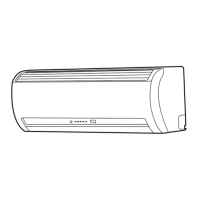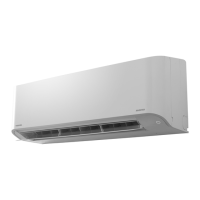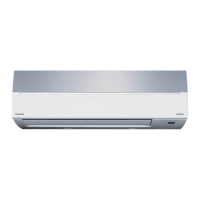
Do you have a question about the Toshiba RAS-13G2KVP-E and is the answer not in the manual?
| Type | Split System |
|---|---|
| Cooling Capacity | 3.5 kW |
| Heating Capacity | 4.0 kW |
| Power Supply | 220-240V, 50Hz |
| Refrigerant | R410A |
| Indoor Unit Weight | 9 kg |
| Noise Level (Outdoor) | 50 dB(A) |
Precautions for installing air conditioners using new HFC refrigerant.
Warnings about electrical shock risks during installation and servicing.
Cautions regarding potential equipment damage from improper installation or use.
Safety precautions for handling R410A refrigerant during installation and servicing.
Guidelines for installing refrigerant piping using appropriate materials and joints.
Lists tools specifically required for R410A installation and interchangeability.
Describes different types of brazing filler materials used for pipe joining.
Provides diagrams and dimensions for the indoor unit's construction and installation.
Lists electrical parts and their specifications for the indoor unit.
Lists electrical parts and their specifications for the outdoor unit.
Illustrates the refrigerant flow and components in the air conditioning system.
Shows the control block diagram for the indoor unit's functions and components.
Provides an overview of the air conditioner's control system and its main functions.
Describes the fundamental operation control of the air conditioner.
Function to remove frost from the outdoor heat exchanger.
Controls the direction of air flow from the indoor unit.
Limits maximum current/power consumption to save energy and extend compressor life.
Step-by-step instructions to enable the auto restart function after power failure.
Identifies and describes the functions of buttons and indicators on the remote controller.
Explains how to operate the remote control, including weekly timer settings.
Illustrates the required clearances and mounting positions for indoor and outdoor units.
Lists optional parts required for installation, such as pipes and insulating material.
Lists all accessories and installation parts included with the unit.
Highlights changes in components and necessary new tools for R410A systems.
Specifies suitable locations for installing the indoor unit, considering space and environment.
Instructions on how to route and insulate refrigerant pipes and drain hoses.
Specifies suitable locations for installing the outdoor unit, considering space, wind, and environment.
Details the flaring process for refrigerant pipes, including dimensions and tools.
Provides instructions for connecting power supply and control cables to indoor and outdoor units.
Describes procedures for checking refrigerant gas leaks using detectors or soap water.
Instructions on enabling and disabling the auto restart function after power failure.
Safety warnings and precautions when working with the new inverter, including high voltage.
Verifies that the power breaker operates correctly.
Checks if the power voltage is within the acceptable range for normal operation.
Identifies normal operations that might be mistaken for malfunctions.
Instructions for accessing and using the remote controller's service mode for diagnosis.
Troubleshooting steps for indoor unit issues and remote controller problems.
Diagnosing why the outdoor unit does not operate due to wiring issues.
Troubleshooting steps when the outdoor unit stops shortly after starting.
Method to check the functionality of the air purifier and ion generator.
Steps for checking the condition and functionality of the indoor unit's PC board.
Procedure to reduce the compressor waiting time during operation.
Detailed instructions for disassembling and replacing main parts of the indoor unit.
Provides exploded views and a parts list for the indoor unit components.











